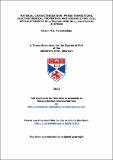Files in this item
Material characterisation, phase transitions, electrochemical properties and possible fuel cell applications of Nd₂₋ₓPrₓCuO₄ and Nd[subscript(2-x-y)] La[subscript(y)]PrₓCuO₄ systems
Item metadata
| dc.contributor.advisor | Irvine, John T. S. | |
| dc.contributor.author | Patabendige, Chami Nilasha Kahakachchi | |
| dc.coverage.spatial | 175 | en_US |
| dc.date.accessioned | 2012-10-16T14:14:10Z | |
| dc.date.available | 2012-10-16T14:14:10Z | |
| dc.date.issued | 2012-03-13 | |
| dc.identifier | uk.bl.ethos.558104 | |
| dc.identifier.uri | https://hdl.handle.net/10023/3181 | |
| dc.description.abstract | The well-known lanthanide cuprates exist in two principal forms, T and T´, which behave as p-type and n-type conductors, respectively. In order to understand the structural properties and crystal chemistry from the T to T´ phase, the Nd₁.₈₋ₓLaₓPr₀.₂CuO₄ (NLPCO) system was studied varying the La substitution ratio (0≤x≤1.8) and then characterised using high temperature X-ray powder diffraction. From analysis of the X-ray diffraction patterns obtained at room temperature, there are clearly five distinguishable regions for the NLPCO system. They are, (1) monophasic T´ solid–solution (2) two phase mixture T´ + T´´ (3) monophasic T´´solid–solution (4) two phase mixture T´´ + O and finally (5) monophasic O phase solid–solution. The T´´ form has previously been suggested as an ordered form of T´; however here we show via high temperature X-ray diffraction studies that it is a non-transformable metastable phase formed on quenching of the T phase via an orthorhombically distorted variant. Also neutron diffraction and selected area electron diffraction (SAED) studies confirmed that the T ´´phase is 4- fold Cu coordinated.The structural, magnetic and electrical properties of this NLPCO series have been investigated for the selected compositions using X-ray diffraction, magnetization measurements, thermal analysis and conductivity measurements. The aim of the second half of this work was to discover the basic high temperature electrical characteristics of Nd₂₋ₓPrₓCuO₄ and investigate how this matches with those required for components on the SOFC cathode side to identify which dopant level shows highest conductivity and whether it is stable at different temperatures. The idea was to make a new concept in SOFC cathodes and current collector development, using n-type conductors instead of p- type conductors and to try to produce a high conductivity material which is stable under the chemical and thermal stresses that exist while under load that can be used in cathode or current collector applications. The Nd₂₋ₓPrₓCuO₄ (NPCO) series has been studied over a range of dopant levels (x=0.15 - 0.25) and maximum conductivity of 86.7 Scm⁻¹ has been obtained for the composition where x = 0.25. Also NPCO shows n-type semiconductor behaviour which gives operational advantages when operating at mild oxygen deficiency. AC impedance studies have been carried out on symmetrical cells to investigate the performance of NPCO as a cathode material. These studies mainly focused on polarization resistance and the activation energies of the cells. Low Rp values and low activation energies are obtained for a composite cathode compared to pure cathode material. Two configurations of NPCO as cathode materials were tested, pre-fired and in-siu fired. Pre-fired NPCO exhibited better performance than in-situ fired NPCO. Both in-situ and pre-fired current collecting NPCO still showed lowest activation energies which suggest good catalytic activity. From all of these studies, it is evident that the praseodymium doped neodymium cuprate material shows considerable promise as a potential cathode material for solid oxide fuel cell applications. | en_US |
| dc.language.iso | en | en_US |
| dc.publisher | University of St Andrews | |
| dc.subject | SOFC cathode | en_US |
| dc.subject | Cuprates | en_US |
| dc.subject | Nd₁.₈₋ₓLaₓPr₀.₂CuO₄ | en_US |
| dc.subject | XRD | en_US |
| dc.subject | Phase diagram | en_US |
| dc.subject | Meta stable | en_US |
| dc.subject | Conductivity | en_US |
| dc.subject | Symmetrical cell testing | en_US |
| dc.subject | Nd₂₋ₓPrₓCuO₄ | en_US |
| dc.subject | N-type semiconductor | en_US |
| dc.subject | AC impedance | en_US |
| dc.subject | Polarization resistance | en_US |
| dc.subject | Activation energy | en_US |
| dc.subject | SAED | en_US |
| dc.subject.lcc | QD172.R2P2 | |
| dc.subject.lcsh | Rare earth metals | en_US |
| dc.subject.lcsh | Copper compounds | en_US |
| dc.subject.lcsh | X-rays--Diffraction | en_US |
| dc.subject.lcsh | Solid oxide fuel cells | en_US |
| dc.subject.lcsh | Cathodes--Materials | en_US |
| dc.title | Material characterisation, phase transitions, electrochemical properties and possible fuel cell applications of Nd₂₋ₓPrₓCuO₄ and Nd[subscript(2-x-y)] La[subscript(y)]PrₓCuO₄ systems | en_US |
| dc.type | Thesis | en_US |
| dc.contributor.sponsor | Engineering and Physical Sciences Research Council (EPSRC) | en_US |
| dc.contributor.sponsor | International Copper Association | en_US |
| dc.type.qualificationlevel | Doctoral | en_US |
| dc.type.qualificationname | PhD Doctor of Philosophy | en_US |
| dc.publisher.institution | The University of St Andrews | en_US |
This item appears in the following Collection(s)
Items in the St Andrews Research Repository are protected by copyright, with all rights reserved, unless otherwise indicated.

